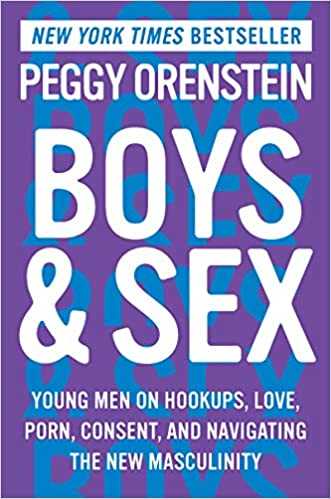
Boys and Sex: Young Men on Hookups, Love, Porn, Consent, and Navigating the New Masculinity by Peggy Orenstein finishes what she started with Girls and Sex, which is also summarized here. Once again she has conducted many interviews with young men and experts in many fields to paint a picture of how the same social forces that impact girls impact boys. Like her book on girls, all parents, boys, and girls should read my summaries and then get the books.
Introduction: What About the Boys?
- For this book Peggy increased the sample size of the boys she interviewed to over 100 (She interviewed 72 for the Girls book.) Again they were in college or heading for college and represented a geographical, racial, and sexual orientation mix. Unlike the “Girls” book she included trans genders here. Although she is old enough to be their mother, she felt that they were generally more forthcoming than the girls. It was also much easier to get parent permission. While parents talk precious little to their daughters about sex, they talk even less about it with their sons.
1. Welcome to Dick School
- Nearlly all of the boys in the study had egalitarian views about girls, thought they were smart and had platonic female friends. This is fairly new. Their definitions of masculinity, however, are right out of the 1950s. They included emotional detachment, rugged good looks, sexual prowess, athleticism, and the potential for wealth. Showing emotions is what girls do, which is not a good thing for boys. The young men who most internalize these masculine norms are more likely to have: sexually harassed a girl, bullied other boys, been victims of verbal or physical violence, engaged in binge-drinking, caused a car accident, been painfully lonely, been less happy, fewer close friends, been depressed, and been suicidal. They clearly pay a big price for being manly as do those around them.
- Generally, boys only discuss emotions and feelings with girlfriends, sisters, and their moms. With women doing the emotional labor, boys end up stunted in a state of arrested development. Toxic masculinity deals with emotional suppression, disparagement of the feminine, and bragging about sexual conquest. This is prominent in the “jock culture” and featured in “locker room talk.” As a result, athletes are three times more likely to be accused of sexual misconduct. In order to see things like rape as ok or even hilarious, boys learn to disregard others’ feelings as well as their own.
2. If It Exists, There Is Porn of It
- The big takeaway here is that today’s children are guinea pigs in a massive porn experiment and assessing porn’s impact isn’t easy as very little research funding is directed its way. All of the boys admitted to watching porn and some admitted to watching a lot. Parents and educators need to understand that porn is where their kids get most if not all of their sex ed. Intentional searches usually start when boys are 12 to 14. This is when most start to masturbate as they watch.
- Watching porn is likely to cause young people to become sexually active sooner, to have more partners, to have higher rates of pregnancy, to be more sexually aggressive, to view women more negatively, and to engage in more risky and atypical sexual behaviors depicted in porn. It can cause less pleasure from partnered sex, concerns about penis size, and anxiety (erectile disfunction) when engaging in foreplay.
- Perhaps main-stream media is more to blame as the scripts boys consume from childhood continuously objectify, demean, and are hostile or indifferent towards women. Unlike porn, which the boys know is about as real as professional wrestling, movies and TV shows are much more believable. Women in the business are often harrassed. The same is true for hip-hop music, the most popular music genre in the US who’s most devoted fans are typically white, suburban boys who are unlikely to know any black people.
3. Are You Experienced? Life and Love in a Hookup Culture
- Hookups presume a lack of connection and commitment although it can be the first step toward a relationship. Physical intimacy is the precursor to emotional intimacy if it happens at all. This is just the opposite of what most people experienced in previous generations. What happens during a hookup is rather vague. It can be anything from making out on the dance floor to intercourse. Some boys never engage in it while others do so every week. It is most common among affluent, white heterosexuals, and predominant in Greek life.
- Hookups are embedded in a school’s drinking culture. “Pre-game” afternoon drinking even when there isn’t a game leads to an evening of more drinking so when it’s time to hookup, both parties are often “hammered.” Boys are often told to ask permission prior to engaging in sex and to make sure the girl isn’t too drunk to know what she is doing. Hookup culture aligns with the values of contemporary masculinity: conquest over a connection, sex as status-seeking, and partners as disposable. Even for boys, they can be an emotional minefield causing inadequacy, anxiety, insecurity, confusion, disappointment, and embarrassment. There is a lot of peer pressure put on boys to hookup and brag about it. If boys understand this, at least they can make educated choices.
DrDougGreen.com If you like the summary, buy the book





